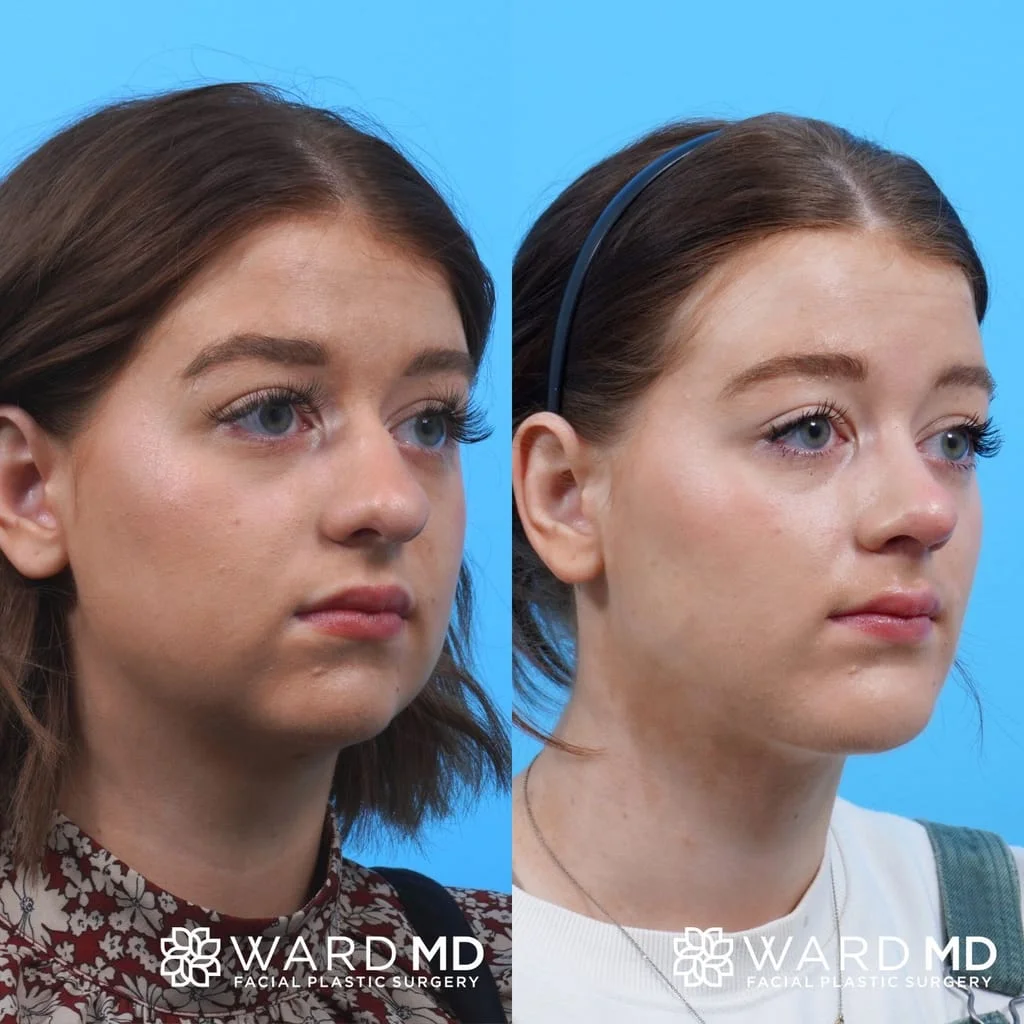Utah’s Leading Facial Contouring Surgeons
Do you struggle with feeling self-conscious about the shape of your face? Do you wish you could enhance your natural beauty by refining your facial features? At the Ward Institute, we offer the latest in facial contouring procedures to help you achieve your aesthetic goals. Our team of skilled and experienced surgeons will work closely with you to create a personalized treatment plan that addresses your unique needs and concerns. Whether you're interested in slimming down your cheeks, enhancing your jawline, or achieving a more youthful appearance, we have the expertise and technology to deliver the results you're looking for. With facial contouring, you can feel confident and beautiful in your own skin.
What is Facial Contouring?
In facial Contouring, Dr. Ward uses facial implants to enhance or augment the physical structure of the face. Dermal fillers can also be used to even out areas, but they are not permanent like the implants.
These are the facial implants generally used for facial contouring:
Chin Implants
These can increase the size and projection of a chin that is deemed “weak” or “recessed” or is simply not in proportion with the forehead and mid-face.
Jaw Implants
Jaw implants increase the width of the lower third of the face. In a similar way to the chin, a weak jaw can be described as one without definition and distinct from the neck, or one that slopes rather than angles from the ear to the chin.
Cheek Implants
These implants increase the projection of the cheekbones. They add volume to areas that may be recessed or flat.

Who Is An Ideal Candidate For Facial Contouring?
Candidates For Facial Augmentation
Many people feel self-conscious about their facial proportions. Augmentation can change that. It can strengthen a jawline or balance the chin or cheekbones with the rest of the face.
With aging, some people feel their face now appears sunken, flattened, or just tired. This is because of the natural slackening of tissues and the declining production of collagen. Implants placed over the cheekbones can return the volume to the cheeks, which is a tenet of a younger face. Jaw implants can strengthen your jawline. Chin implants can add proportion or balance to a face.
To be a good candidate, you should be generally healthy, without active diseases or conditions. It helps if you’re not a smoker. If you are, you’ll need to stop for at least one month prior to and after your augmentation.
Procedure Description
How Is Facial Augmentation Performed?
Most facial implants are made of silicone. Others are made of polyethylene or Gore-Tex. All of the materials are compatible with the human body and are used in other surgeries. Here are the methods Dr. Ward uses for placing implants in the three main areas. For each type of implant, he makes an incision and then creates a pocket to hold the implant:
Lower Jaw Implants
The implant is placed inside the lower lip, back along the jawline at the crease where the inside of your cheek and gums meet. Your incisions will be closed with absorbable sutures that will dissolve in about one week.
Chin Implants
These implants are placed through your lower lip along the crease that joins your lower lip and gums. An alternate location is through a small incision made under the chin.
Cheek Implants
The incision for cheek augmentation is made inside the mouth or along the lower eyelid
Recovery Process
These are not difficult recoveries. Because there isn’t much tissue repositioning and subsequent trauma, there is little bruising and swelling with the placement of facial implants. Pain is usually manageable with over-the-counter pain medication. Dr. Ward may have certain implant areas covered with bandages to support the implant during the initial healing phase. We’ll give you detailed instructions on caring for your incision or incisions, whether they are inside the mouth, under the eyelid, or under the chin.
It will help to sleep with your head elevated for the first week. This minimizes any swelling. Obviously, you’ll also have to not sleep on your face.
Most patients can return to work in just 5 to 7 days. Of course, if you’re combining your facial augmentation with other procedures, such as a facelift, your recovery will be predicated on that.

FACIAL CONTOURING RESULTS
These are minor surgeries, but they are surgeries and they involve the same risks: excessive bleeding, poor wound healing, infection, and the like.
For facial augmentation, the risks are possible nerve damage, numbness, skin discoloration, and fluid build-up. These are usually temporary. There is a slight risk of the implants shifting or of asymmetry between both sides of your face.
TESTIMONIALS

Facial Contouring FAQ
The cost of facial contouring procedures, including buccal fat removal, jawline augmentation, and cheek augmentation, can vary depending on various factors such as the specific procedures performed, the surgeon's experience, the geographic location, and other associated fees. It is best to consult with a board-certified plastic surgeon who can provide you with a personalized cost estimate after assessing your needs and desired outcomes.
In general, these cosmetic procedures are considered elective and are typically not covered by insurance. Insurance providers usually do not cover procedures that are performed for purely cosmetic reasons. However, if there are functional concerns or medical conditions associated with these procedures, such as breathing difficulties or facial asymmetry due to a congenital condition, insurance coverage may be possible. It is advisable to check with your insurance provider to understand the specific coverage details and requirements.
The results of facial contouring procedures, such as buccal fat removal, jawline augmentation, and cheek augmentation, can vary depending on individual factors and the specific techniques used. Here are some general expectations:
- Facial Contouring: Facial contouring aims to enhance the overall balance and proportion of the face. The specific changes achieved will depend on the areas targeted and the techniques employed. Results can include improved facial symmetry, enhanced definition of facial features, and a more sculpted appearance.
- Buccal Fat Removal: Buccal fat removal is designed to reduce the fullness of the cheeks. It can create a more defined cheekbone structure and a slimmer facial profile. The results are typically permanent, as the removed fat does not regenerate.
- Jawline Augmentation: Jawline augmentation can involve procedures such as chin implants or jawline contouring with dermal fillers or implants. The goal is to create a more defined and balanced jawline, which can contribute to a more youthful and harmonious facial appearance. The duration of results can vary depending on the specific technique used.
- Cheek Augmentation: Cheek augmentation is performed to enhance the volume and contour of the cheeks. This can involve techniques such as dermal fillers, fat grafting, or cheek implants. The results can provide a more youthful and lifted appearance, and their longevity depends on the chosen method.
It's important to have a thorough consultation with a board-certified plastic surgeon who can assess your unique facial anatomy, discuss your goals, and provide realistic expectations for the results. The longevity of the outcomes can also be influenced by factors such as aging, lifestyle choices, and individual variations in healing and tissue response.
Yes, there are non-surgical alternatives available for facial contouring, buccal fat removal, jawline augmentation, and cheek augmentation. These alternatives may be suitable for individuals who prefer non-invasive or temporary solutions, have milder concerns, or are not ready for surgical procedures. Some non-surgical options include:
- Dermal Fillers: Dermal fillers can be used to enhance facial volume, contouring, and lift. They can provide temporary results and are commonly used for cheek augmentation and jawline contouring.
- Neurotoxin Injections: Neurotoxin injections, such as Botox, can be used to relax muscles and achieve subtle changes in facial shape and contour. They are often used for jawline slimming and reducing the appearance of facial wrinkles.
- Thread Lift: Thread lift is a non-surgical procedure that uses dissolvable sutures to lift and reposition sagging facial tissues. It can provide a subtle lift and improve facial contours without invasive surgery.
- Non-Surgical Fat Reduction: Non-surgical fat reduction treatments, such as cryolipolysis (coolsculpting) or radiofrequency-based procedures, can be used to reduce fat in specific areas of the face.
It's important to consult with a qualified aesthetic practitioner who can assess your needs and recommend the most suitable non-surgical options for your desired outcomes.
Choosing the right surgeon for facial contouring, buccal fat removal, jawline augmentation, and cheek augmentation is crucial for achieving safe and satisfactory results. Here are some considerations to help you in the selection process:
- Board Certification: Ensure that the surgeon is board-certified by a recognized board in plastic surgery or a related field. Board certification indicates that the surgeon has undergone rigorous training and meets high standards of expertise and ethics.
- Experience and Expertise: Look for a surgeon who has extensive experience and specialized expertise in facial plastic surgery. Review before and after photos of their previous patients to assess the quality and consistency of their work.
- Reputation and Reviews: Research the surgeon's reputation and read reviews from their previous patients. This can provide insights into patient satisfaction, the surgeon's bedside manner, and the overall patient experience.
- Consultation: Schedule a consultation with the surgeon to discuss your goals, ask questions, and assess their communication style and approach. The surgeon should listen to your concerns, provide realistic expectations, and tailor a personalized treatment plan.
- Facility Accreditation: Ensure that the surgical facility where the procedure will be performed is accredited and meets recognized safety standards.
- Personal Comfort: Trust your instincts and choose a surgeon with whom you feel comfortable, respected, and supported throughout your surgical journey.
By considering these factors and doing thorough research, you can increase the likelihood of finding a skilled surgeon who can deliver the desired results with a focus on patient safety and satisfaction.
Pain and discomfort levels can vary among individuals and the specific facial contouring procedures performed. However, the surgical techniques and advancements in anesthesia have made these procedures generally well-tolerated with manageable pain. Here are some insights:
- During Surgery: Facial contouring procedures are typically performed under anesthesia to ensure a pain-free experience during the surgery. General anesthesia or intravenous sedation is commonly used, and you will be asleep and unaware of the procedure.
- After Surgery: Some discomfort, swelling, and bruising are normal after facial contouring procedures. However, these symptoms can be effectively managed with appropriate pain medications prescribed by your surgeon.
- Pain Management Options: Your surgeon will provide instructions on pain management after the surgery. This may include prescription pain medications for the initial days, followed by over-the-counter pain relievers as needed. Cold compresses, elevation of the head, and avoiding strenuous activities can also help alleviate discomfort and reduce swelling.
- Open Communication: It's essential to communicate any concerns or pain you experience with your surgeon during the recovery period. They can adjust the pain management plan or provide additional guidance to ensure your comfort.
Remember, everyone's pain tolerance and recovery experience can vary. Following your surgeon's post-operative instructions and attending follow-up appointments are crucial for optimal healing and pain management.
Preparing for facial contouring procedures involves both physical and mental readiness. Here are some general guidelines:
- Physical Preparation:
- Follow your surgeon's pre-operative instructions, which may include avoiding certain medications, supplements, and herbal remedies that can increase the risk of bleeding.
- Quit smoking at least a few weeks before the surgery, as smoking can impair healing and increase complications.
- Maintain a healthy diet and lifestyle to optimize your overall health and immune system.
- Arrange for a responsible adult to drive you home after the procedure and stay with you during the initial recovery period.
- Stock up on any recommended post-operative supplies, such as prescribed medications, cold compresses, and soft foods.
- Mental Preparation:
- Have realistic expectations and discuss your goals with your surgeon during the consultation.
- Address any emotional or psychological concerns you may have about the surgery by seeking support from loved ones, friends, or a mental health professional.
- Educate yourself about the procedure and the recovery process to have a better understanding of what to expect.
- Prepare your recovery space with comfortable pillows, entertainment options, and items that can help you relax.
- Stay positive and trust in your surgeon's expertise and the outcome of the procedure.
Following your surgeon's specific pre-operative instructions and maintaining a positive mindset can contribute to a smoother surgical experience and recovery.
As with any surgical procedure, facial contouring, buccal fat removal, jawline augmentation, and cheek augmentation carry potential risks and complications. While the overall complication rate is generally low, it's important to be aware of the possibilities. Some potential risks include:
- Infection: Infections can occur after surgery, although they are relatively rare. Your surgeon will provide instructions on how to minimize the risk of infection and may prescribe antibiotics.
- Bleeding: Some bleeding is expected during and immediately after the surgery. However, excessive bleeding or hematoma (a collection of blood) can occur, requiring medical attention.
- Scarring: Incisions made during facial contouring procedures will result in scars. However, skilled surgeons make incisions in inconspicuous areas whenever possible to minimize the visibility of scars.
- Unsatisfactory Results: While efforts are made to achieve the desired outcomes, it's important to understand that results can vary and may not meet your exact expectations. Open communication with your surgeon during the consultation can help set realistic goals.
- Nerve Damage: Facial contouring procedures involve working around delicate facial nerves. In rare cases, nerve damage can occur, leading to temporary or permanent changes in sensation or muscle function.
- Asymmetry: Achieving perfect symmetry in facial contouring is challenging. Some degree of natural facial asymmetry may persist or develop after surgery.
Your surgeon will discuss these risks, as well as steps they take to minimize them, during your pre-operative consultation. It's important to carefully follow your surgeon's post-operative instructions to reduce the risk of complications and optimize healing.
The Consultation
Dr. Ward views your consultation as a sharing of information between the two of you. He’ll ask you your goals and things you don’t like about the proportions of your face. What are you happy with? What do you not like? How would you like to add proportion?
Dr. Ward then details your options. Where implants could be useful. Where fillers would be better. He’ll tell you what can be realistically achieved.
This should be a free flow of information in both directions. This will include possible risks and complications with facial augmentation.
The two of you will go through your medical history. You’ll discuss previous surgeries you’ve had and all medications or supplements you’re taking. Dr. Ward then conducts a complete examination of your face, including the skin and underlying bone structure.





